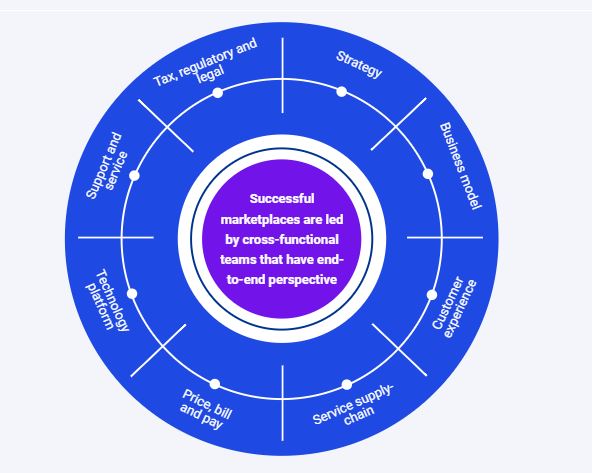I recently published a blog post explaining the reasons behind the relative explosion of B2B marketplaces, along with recommendations for those considering entering this space.
In this follow up (the second in a series of three), I’m looking to delve deeper into the eight key elements that should be considered for any organization looking to take advantage of the significant B2B marketplace opportunity.
In the body of this blog post, I discuss the relevance of each of these areas in turn; before delving into the detail, however, let’s consider the critical nature of, and implicit connection between, the following three principles.
Follow the product, Follow the money, Follow the experience
For a successful marketplace, at a base level, one must follow the experience, follow the product, and follow the money. A strong focus on only one aspect will not make up for bad practices in the others. For instance, having a great user experience will not make up for poor supply chain management or laborious payment experiences.
Additionally, your experience isn’t just about the buyer. The vendors and employees who are interacting with your channels are of equal importance.
Getting vendor onboarding right is important to drive positive vendor experiences and competitive pricing advantages; employees, meanwhile, must be able to quickly and accurately track information, the right talent must be available, and they must have the training required to support operations and customers.
A winning user experience should successfully align the right vendors and prices with channel organization managed operations, and the ability for buyers to efficiently find and purchase the products and services they require.
An enterprise-wide perspective is crucial

Launching a B2B marketplace is complex. Getting it right requires an enterprise-wide, strategic vision and execution. Many organizations lack an understanding of the complexity involved in launching a successful marketplace – starting with the mistaken belief that a technology platform, a strong business model, and a thought-through go-to-market strategy will suffice.
Although all three of these aspects are absolutely important, they are just three of what I believe to be the eight crucial elements that need to be considered for any successful B2B marketplace.
From initial decisions on whether to enter this space, through the gathering of relevant data, to building and then sustaining a platform, marketplaces need to focus on an enterprise perspective. I’ll take a look at each of these key building blocks in turn:
Strategy
Your strategy involves the story you want to tell, discovering the value, and creating the setting for customer growth, revenue growth, and scale. You should take the time to understand:
- What people are interested in.
- The competitive landscape and the current channel.
- The possible need for a fundamental change or to create a new channel and business model that connects all functions of the business.
This is often a collaboration between key members of an internal strategy team who consider the running of your business, the advising/counsel of the business, and the operational support that will be needed (CEO, sales, CIO/CTO, procurement, legal counsel, operations).
Business model
This element involves the need to understand how your business will need to change to account for a new model, and which model you will choose. This is not just about determining if you want to be a reseller, do rebates or negotiate referrals. It’s making decisions in key areas such as:
- Monetization approach (subscriptions, advertising, revenue sharing, etc.).
- Seller of record and taking title for 3rd party products.
- Vendor partnering approach (degree of exclusivity, co-investment, and co-marketing).
- Data sharing and privacy/contract terms.
- Billing, invoicing and reporting.
It’s easy to get enamored with the revenue and growth opportunities, but it is critical that you pick the right model or combination of models that fit your requirements best, based on the type of products/services you want to offer, your intended time to market, and contractual considerations.
Customer experience
Customer experience should always consider the interrelated experiences of the buyer, the vendor (seller), and the company employees – all three sets of stakeholders are equally crucial to the success of a B2B marketplace.
There are times when buyer experience is “compromised” in one area to create a better buying experience in another area (e.g., customers will give up some user design elements if the product information and availability is always accurate and delivered when expected) – I’m sure we can all think of a ‘prime’ example that attracts huge volumes of buyers and sellers but won’t be winning any awards for their user experience.
- A trusted marketplace where a buyer is provided with a seamless experience, one which delivers on promises, and provides a competitive advantage over another marketplace, will engender loyalty.
- An outside-in alignment with customer needs/values, that addresses speed/simplicity and adoption/retention barriers will provide a top-notch experience.
- Aligning self-sufficient digital experiences with strong customer support provides the best multi-channel experience.
Services supply-chain
It is vitally important to ensure the vendor experience and the employee experience are aligned in order to provide great customer support and user-friendly catalog management.
- Vendor selection (including evaluation of vendors, establishing conflict resolution and/or exclusion readiness, and assessing reputational risk) is imperative. Who you invite into your marketplace, and how they do business, directly impacts your business’s reputation.
- The contracting and on-boarding experience will impact whether or not vendors are attracted to your marketplace. Establishing partner incentives and value-sharing agreements will drive competitive pricing, resulting in your marketplace being enticing to buyers.
Price, bill and pay
As your marketplace grows with multiple vendors, products, services, and payments, the complexity of the system increases. Price, bill and pay schedules become imperative for your customers and vendors to line up during the marketplace experience. You should consider:
- The need for any anti-money laundering/know your customer (AML/KYC) requirements.
- Subscription order and service order requirements.
- Entitlements and consolidated billing needs.
- Product and pricing maintenance.
- Product relevancy, volume and management.
Technology platform
While deciding on the best technology platform for your requirements will obviously play a crucial role in your success or otherwise, it can be easy to have a myopic focus on the marketplace technology without thinking of the business ecosystem that enables the platform or lose focus on the need to invest in the wider business as it becomes more digital.
- Your business must avoid over-architecting and creating unnecessary ‘tech debt’.
- Disparate data sets, across multiple locations, can hinder implementation and create further technology misalignment. Data handling, identification, management, curation and presentation is key to delivering on a great experience. Without the right focus, inefficient data management can prevent you from hitting timelines or create challenges to producing products and services.
- When following the money, choosing the correct technology for the payment gateway, payment processing, operational considerations, and requirement regulation/compliance will garner much needed support from your CFO and General Counsel and could help keep you out of an orange jumpsuit.
Support and service
The balance of operational efficiencies, financial benefits and reputational risk often lie at the heart of strong support and service.
In the support and service ecosystem, the buyer, the vendor, the employee, and governance all require a voice and focus. This element is often the most impacted by the new or changed marketplace if the experience does not go well.
- Proper talent, training, and standard operating procedures for customer support are imperative. The likely increase in new buyers and vendors, additional regulations and new vendor agreements all have the potential to create issues if not proactively managed.
- Returns and refunds has a high potential for friction, even when there is stated ownership, especially if third-party vendors are involved. The responsibility for excellent customer experience should not be relinquished by your business – retaining control and responsibility for the overall user experience will drive high standards for your brand, ensuring quality is retained, and maximizing your chances of a smooth post-sell process.
- Smooth support and service experiences help keep all of your significant stakeholders – buyers, vendors, and employees – engaged and loyal.
Tax, regulatory and legal
New business models and ways of operating may (and, indeed, should) challenge you to rethink your contracts and policies.
- The level of Tax complexity, decisions, and technology support can substantially increase as your expanded assortment and reach includes new products, services and territories. Investing in tax strategists will help with policy, licenses and compliance, and prepare for operational impacts long after the launch.
- Tax is a critical stakeholder but is not the final driver for business. You must weigh the options then decide what is non-negotiable for your business vs. what new risks are acceptable for your new business model. There needs to be a give and take between Legal, Finance and your Business Operations.
- Your level of risk taking, and willingness to take risks, may change (or need to change) with the new business model.
Recommendations
If you do decide that launching a B2B marketplace is for you, then I would recommend the following considerations are addressed up front, and throughout the product lifecycle:
- Have a clear business model and shared vision.
- Recruit and integrate strong resources early.
- Choose and manage vendors wisely.
- Relentlessly track flow of funds.
Concentrate on these focus areas, proceed with an enterprise-wide approach, and ensure that all eight crucial marketplace elements are at front of mind throughout your journey, and you will give yourself the best chance of reaping the rewards.
Explore more
Meet our team


